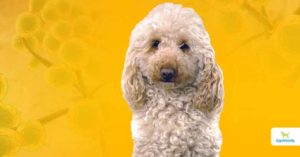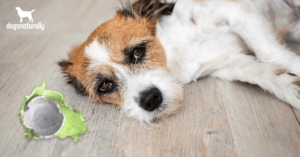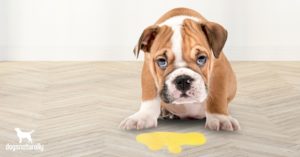No other word strikes terror into the hearts of puppy owners like parvovirus. I know this first hand because I was once in the position that every puppy owner dreads … watching my puppy dying in front of my eyes.
I felt such overwhelming guilt for not vaccinating my puppy … he was pale, lifeless and fading fast. I’ll remember that moment for the rest of my days, the moment when the vet said “well, that’s what you get for not vaccinating.
It was like a slap in the face. I wondered to myself, “Was I being irresponsible for not vaccinating my puppy? Was I irresponsible for treating Aaron at home instead of leaving him to despair and possibly die alone in a cage at the back of the vet clinic?”
It would have been so easy to cave to convention and swear that I would diligently vaccinate my dogs from now on and never have to suffer through that horrible situation again. But it wasn’t until Aaron and I had to stare parvo right in the face that I discovered it wasn’t as horrible as I feared.
Because something wonderful happened … Aaron got better.
I admit that at the time refusing traditional medical care for my puppy was one of the most difficult things I’d ever done. And I promise that if parvo ever strikes your puppy, it will be no less difficult for you. Thankfully, there were wonderful people who supported me and armed me with the tools I needed to help Aaron heal.
What follows is not a How To Fight Parvo guide, nor is it a replacement for veterinary advice. What I wish to give you is the insight of somebody who chose not to vaccinate for parvo, fought the disease at home and came out on top.
The road was rocky, but looking back, my experience with parvo didn’t cause me to rush back to the vaccines. It only proved to me that the decisions I had made were the right ones.
I hope that after reading this article, you will think so too.
RELATED: Everything you need to know about the parvovirus vaccine …
What Is Parvo In Dogs?
Briefly, parvovirus (parvo) is a viral infection that quickly attacks rapidly dividing cells in your dog’s body. Cells like those present in the lining of the digestive tract or in developing white blood cells.
The hallmark of parvo is blood-stained feces with a very distinct and unpleasant smell. Other early symptoms of parvo in dogs are fever and no appetite, vomiting and diarrhea. Parvo itself rarely kills dogs. It’s the associated dehydration and secondary infection that can be deadly.
If you think your puppy has parvo, ask your vet to analyze a stool sample for parvo antigens using a SNAP test. Most vets have this test available right in their clinic. The vet may also run blood work to measure your puppy’s immune cells and hydration to see how sick he is.
How Do Dogs Get Parvo?
Parvo spreads through contact with infected feces, dog to dog or through contact with infected items like food and water bowls, collars and leashes, clothing … and at vet offices if an infected dog has been there.
Parvo Treatment At Home
Looking back, I’m glad I treated Aaron at home. Many vet clinics keep puppies over-night but don’t have staff on hand to actually watch them. I was able to give Aaron round the clock care and he was in his own bed, surrounded by his family. He didn’t suffer the added stress of staying in a cage at the vet clinic.
If I ever have to face parvo again … I will still opt to treat my puppy at home.
The following is what experience has taught me. It’s not intended to represent medical advice.
Find A Holistic Vet
Even though I was not able to do so, I do highly recommend you care for your puppy under the direction of a holistic vet or homeopath. Make sure you find one before you get your puppy, so you’re prepared in an emergency. Parvo may be survivable … but it’s a serious disease. Parvo treatment at home is possible, but don’t try to do it alone.
Stick to your convictions and find a vet who will treat your puppy without damaging his immune system. There are many vets who call themselves holistic but are quick to dispense the antivirals.
If your vet chooses this option and you feel it isn’t right, there are plenty of good homeopathic or other holistic vets who will do phone consults (find one at theavh.org or ahvma.org). I speak from hard-earned experience when I say “if it doesn’t feel right, it probably isn’t”. Be an active partner in your puppy’s health care.
If your dog is infected with parvo, there are 3 areas you need to cover …
- Hydration
- Diarrhea
- Blood Sugar
1. Keep Your Puppy Hydrated
Parvo itself isn’t the worst threat. Severe dehydration is much more dangerous. If your puppy can’t keep his liquids down by mouth … you need to get them into him another way.
To check for dehydration: Pinch the skin at the back of your puppy’s neck. It should bounce back immediately. If the fold takes 2 seconds or longer to return to normal, your puppy’s dehydrated. You need to get fluids into him fast.
There are a few ways to do this …
Intravenous Fluids
An IV is normally something that needs to be done at a veterinary clinic. A catheter gets inserted right into the vein and fluids head directly into the bloodstream.
If you wish to treat your puppy at home, you still have the option to take him to the vet for an IV. When my puppy was falling behind, I brought him to the vet for an IV and they administered his Parvaid (from Amber Naturalz, now called Paxaid) and his parvo nosode for me while he was there. He was there for about four hours, then I brought him back home again and continued with his treatment.
Subcutaneous Fluids
Your vet can send you home with a sub-Q kit and show you how to use it … or you can buy one online (and find demos online too).
This option involves placing a catheter just below the skin to create a pocket of fluid, which the body then absorbs. Some people find that sub-Q methods are too slow and if the puppy is still vomiting or has diarrhea, he can still dehydrate.
PRO TIP
If giving sub-Q fluids, make sure you warm them to body temperature. To do this, place the bag in a warm bowl of water for 10 minutes or so. To check the temperature, drop a few drops from the needle on your wrist. You don’t want to burn your pup.
Enema Fluids
Enemas can be the most effective way to give fluids to your puppy at home and it has a good track record.
The amount of fluid you give depends on the puppy. Puppies less than 10 lbs would need about 10 ml of fluid whereas puppies 40 lbs or more would need 60 ml. To find out exactly how much to give your puppy, ask your holistic vet.
You can give enemas several ways …
- Infant enema bag
- Bulb syringe
- Standard, clear syringe with catheter tip (not the kind made for needles)
Like sub-Q fluids, you want to warm the fluids to body temperature first. (See the Pro Tip for Sub-Q above.)
You want to administer the enema very slowly … over several minutes. If you go too quickly, the fluid will just start to squirt out. If the puppy does not need the enema, the fluid will simply come back out again, no matter how slowly you go.
You may also want to add electrolytes to his water. This will rehydrate your puppy and replace the minerals and electrolytes he’s lost. Pedialyte is a safe product for your puppy. The amount you give will depend on how big your puppy is and how he’s doing. So ask your holistic vet for the best dose for your puppy.
You can also use homemade oat water as an electrolyte replacement for Pedialyte.
Oat Water Recipe
1/2 gallon filtered water
1 cup of oats (not instant oatmeal; Quaker Old-Fashioned Oats are OK, or buy organic oats at your health store)
1/3 cup molasses
1 tsp sea salt
Bring the water to a boil. Add oats, salt, and molasses. Simmer for 5 minutes then let sit for 20 minutes. After 20 minutes strain off the oats and use the water.
Oral Fluids
The above methods are only needed until your puppy is able to hold down fluids himself. Once he’s able to do so, start to give him Pedialyte or oat water by mouth. This will help replace the minerals and electrolytes he has lost from vomiting and diarrhea.
- Give Pedialyte at least every hour. Start with small amounts (just drops) often and watch your puppy. If you give too much, he may vomit it back up.
- Once he’s stopped vomiting, offer room temperature sips every half hour. Stop and return to drops if he can’t keep it down.
- Increase the amount you offer until there’s no more vomiting.
- Once vomiting stops, let him have free access to a water bowl.
To help your puppy keep his fluids down, you can add some ginger tea to his fluids. Ginger can help ease the symptoms of nausea and vomiting. It’s also very helpful in increasing the immunity of the body. You could also add Turmeric to the tea for the same reasons.
Ginger Tea Recipe
1 quart of water
4 tsp dried ginger or a few thin slices of fresh ginger
Bring water to a boil and add ginger. Simmer for 10-20 minutes. Strain the liquid and let it cool. Give the ginger tea along with a small amount of electrolyte fluid or oat water.
2. Get Control Of Your Puppy’s Diarrhea
Diarrhea can also cause fluid loss and dehydration. It’s important to address diarrhea as quickly as possible. It may be tempting to use an over-the-counter product to stop diarrhea but you shouldn’t. Herbal and homeopathic treatments will work best without being suppressive.
There are commercial herbal products available to help your puppy with his diarrhea. The good thing about these products is that you can take advantage of customer service and the company’s experience.
When Aaron was sick, I chose to use Paxaid by Amber Naturalz (formerly called Paxxin or Parvaid). They picked up the phone immediately to talk me through the entire process. This was immensely useful because I had no veterinary guidance. (Though you will, if you followed my earlier advice to find a holistic vet!)
There are other products available but … do your homework. You want to know what their success rate is before purchasing. If possible, talk to people who have used them.
3. Manage Your Puppy’s Blood Sugar
You also want to watch your puppy for low blood sugar.
The simplest way to check his blood sugar levels is to look at the color of his gums. Normal gums should be a nice pink color. Some dogs have brown or black gums, but there should still be some color.
White or pale gums mean his sugar level is low. If you see pale gums, there are some ways that you can help …
Molasses
To boost your puppy’s blood sugar, rub molasses on his gums every hour. You should notice an improvement in his gum color and energy level.
If you don’t, then try beef liver puree by mouth.
Beef Liver Puree
You can feed your puppy beef liver 2 ways …
- By mouth if he can keep food down.
- As an enema if he can’t keep food down.
Give beef liver puree every 3 hours. But don’t give more beef liver than recommended or it may cause more diarrhea. Here is doing information based on your puppy’s weight.
Under 3 lbs 1/8 tsp
2 to 3 lbs 1/4 tsp
4 to 10 lbs 1/2 tsp
11 to 20 lbs 1 tsp
21 to 30 lbs 2 tsp
31 to 40 lbs 1 Tbsp
41 to 50 lbs 2 Tbsp
Add an extra 1 Tbsp for every 10 lbs of body weight over 50 lbs
Beef Liver Puree Recipe
2 slices of beef liver
Oat water or electrolyte fluid (such as Pedialyte)
1/4 ripe banana
Boil the beef liver until thoroughly cooked. Blend and add enough oat water or other electrolyte fluid to thin the beef liver. You want it to be thin enough to suck up into a syringe. Add the banana and then add more oat water or electrolyte fluid if needed.
Parvo Medications
If your dog gets infected with parvo, you may be tempted to use over the counter drugs. The problem is … these can suppress the immune system.
Tamiflu is an antiviral that’s often used to treat parvo-infected dogs. But like antibiotics, antiviral meds can result in further mutations of the virus as it adapts to its environment. Tamiflu is not approved or formulated for small animals. A pharmacist has to compound it or a veterinarian has to put into suspension.
Parvoviruses, like flu viruses, are mutation-prone. Experts are not surprised they evolve and become resistant to Tamiflu … just as bacteria develop resistance to antibiotics.
Research on Tamiflu
Researchers in Indonesia have discovered that the combination of vaccination and Tamiflu caused the emergence of more lethal strains of Bird Flu. In humans, Tamiflu-resistant swine flu cases have been reported in Vietnam, Japan, Hong Kong, Denmark and the United States.
There’s no research to show whether the use of Tamiflu is partly responsible for the mutation of parvovirus. In fact, there’s no research on Tamiflu on small animals at all. All reports of the effectiveness of Tamiflu are strictly anecdotal from shelter experience and private veterinary practices.
Human studies on Tamiflu are not remarkable either. The FDA even requires its manufacturer, Roche, to print the following disclaimer on Tamiflu labels:
“Tamiflu has not been proven to have a positive impact on the potential consequences (such as hospitalizations, mortality, or economic impact) of seasonal, avian, or pandemic influenza.”
An FDA spokesperson even told the British Medical Journal,
“The clinical trials … failed to demonstrate any significant difference in rates of hospitalization, complications, or mortality in patients receiving either Tamiflu or placebo.”
That isn’t to say antivirals are not important. Parvovirus leaves your dog open to a secondary infection because of a marked loss in white blood cells. It’s important to give your puppy an antiviral to prevent this. You can choose an antiviral your vet prescribes … or you can choose from safe and effective natural choices.
Natural Antivirals
Earlier, I mentioned Amber Naturalz … the company who surveyed their customers on the impact of the parvo vaccines in dogs. They produce a herbal antiviral product that’s designed to work with Paxaid (see above), called Vibactra Plus.
There are also essential oils that have antiviral activities including eucalyptus oil and tea tree oil. Or you can try these antiviral herbs …
- Garlic
- Oregano
- Echinacea
- Mullein
- Licorice
If you choose to use either essential oils or herbs, it’s best to do so under the guidance of a good herbalist or holistic vet.
Homeopathy For Parvo Infected Dogs
Homeopathy can be incredibly fast-acting in acute situations. You should ideally have the guidance of a good homeopath, but the following remedies often work very well. Because homeopathy is prescribed based on symptoms and not the disease, it’s not necessary to wait for a diagnosis of parvo to begin using the remedies (except for parvo nosode).
Homeopathic remedies usually come as pellets or granules. You can buy homeopathic remedies at a local health food store or apothecary. If you don’t have one nearby you can order online.
The best way to give them is as a liquid dose:
- Add 2 or 3 pellets or a few granules into a small glass of filtered or spring water. Never used unfiltered tap water. Don’t touch the pellets with your hands as this can negate the remedy.
- Stir well (about 20 times). The pellets may not dissolve completely, but the remedy is now in the water.
- Use a dropper or teaspoon to put some of the liquid on your puppy’s gums.
- Store in a dark place like a kitchen cabinet for later. Don’t refrigerate. It will keep for 2 or 3 days.
- Stir the water again before every dose.
After each dose, wait and watch your puppy’s progress closely.
- If you see improvement … then wait.
- If you see improvement, then he backslides … re-dose immediately (this may be in an hour, this may be in five minutes, it depends on your puppy).
It’s better to give one dose too many than not enough. You’ve got a short window with one chance to stimulate your puppy’s vital force. If you don’t give enough support, it can be very hard to get him back a second time.
If there’s no change at all … try a higher potency or move on to another remedy.
As a general guide, check your puppy every hour to see if you need to repeat the remedy.
Here are some remedies you may want to use for parvo symptoms in dogs.
1. Aconitum napellus 30C
If you suspect your puppy may have parvo, don’t wait – give him Aconite immediately, even if it’s on the way to the vet’s office. Aconite is for intense physical symptoms that occur suddenly with associated fever and stress.
2. Phosphorus 30C
This remedy is very effective for vomiting, especially if the vomit contains blood.
3. Arsenicum album 30C
This is the main remedy for controlling acute diarrhea.
4. Mercurius corrosivus 30C
Useful if there’s blood in the feces, often with much straining and discomfort.
5. Crotalus horridus 30C
You should add this remedy if there are copious amounts of blood in the stools. Give it to your dog frequently along with other parvo remedies.
6. China officinalis 30C
You can use this remedy with the above remedies to prevent dehydration and restore strength after loss of fluids. You can use it in the acute stage or to help recovery after you get the vomiting and diarrhea under control.
Parvo Nosodes For Dogs
Nosodes are effective, inexpensive and easy to give. Although nosodes are more commonly taken as a preventive, they’re a powerful synergist to the homeopathic remedies above.
Puppies treated with nosodes have a high survival rate and it’s often better than puppies treated with traditional methods like Tamiflu. You can buy nosodes through a homeopathic veterinarian.
Gloria Dodd DVM reported very good results with the parvo nosode in her practice.
“In the very first days of parvovirus infection in dogs,” Dodd states, “I was faced with an overwhelming epidemic of parvo-stricken dogs in my clinical practice. I made a 30C nosode from the infected animals’ blood in the form of a sterile saline solution, and then injected the nosode intravenously into the sick animals.
I never lost one animal of the hundreds that came to me in the early epidemiology. These were dogs with other pathologies: Congestive Heart problems, Chronic Interstitial Nephritis, and very old and very young dogs with compromised immune systems.”
Fecal Transplant
Fecal microbiota transplants (FMV) are an emerging treatment for digestive health problems. FMT is the transfer of healthy stool from a donor to the gastrointestinal tract of an infected recipient. This allows beneficial bacteria and other organisms from the donor to help restore the microbiome of the sick dog.
A recent study showed that FMT is a good option in puppies with parvo as it can help manage diarrhea and speed recovery.
How To Reintroduce Regular Food
Once your puppy can hold down water, you can offer him food. But start slowly to be sure he can keep it down. His digestive system will still be raw, damaged and susceptible to bacteria. If he normally eats a fresh raw diet. Don’t feed raw for at least 2 weeks after he starts to eat again.
You want to resolve all your dog’s parvo symptoms first with a nice bland diet to help his stomach transition. Soup is a good way to start reintroducing food.
Post-Parvo Soup Recipe
3 to 4 chicken thighs
6 cups of water
(optional) celery, carrot, yam and cauliflower
Place chicken thighs in water. Bring to a boil and simmer for 1½ to 2 hours. Remove skin and bones and set meat aside. Strain broth and use it to boil 1 to 2 cups of chopped vegetables for 20 minutes. Allow it to cool before serving.
When you’re ready to serve, start small … a few teaspoons for very small dogs, and up to ½ to 1 cup for larger dogs. Small meals will reduce the burden on his digestive system. Allow 4 to 6 hours to pass between meals. Watch for any diarrhea or vomiting after meals.
Home Support While On The Mend
Once your puppy drinks and eats well for 48 hours without vomiting, you can start to use these remedies to support his recovery. It’s OK to buy products made for humans.
Start one new supplement at a time so that his body can adjust. Wait 24 hours before you start each new supplement unless otherwise stated.
Bio-12 Homeopathic Tissue Salts
Tissue salts are also called cell salts. They’re gentle homeopathic remedies that provide the minerals the cells need. There are 12 tissue or cell salts.
Bio-12 or Bioplasma, is a combination of all 12 tissue salts in one. This remedy helps with proper rehydration and cell development.
Dosing For Bio-12 Tissue Salts: Give 2 tablets 3 times a day for 1 week, then once per day for 1 month. You can buy tissue salts at natural health stores or at Amazon or other online sellers.
N-Acetyl-Glucosamine
N-Acetyl-Glucosamine (NAG) is for joint and gastrointestinal problems. It’s easiest to use in powder form. If you buy capsules, just open the capsule and empty out the powder.
Dosing For N-Acetyl Glucosamine: Dose according to size for 10 days, then go to half the amount for 3 months.
Up to 5 lbs 25 mg twice per day
6 to 15 lbs 50 mg twice per day
16 to 30 lbs 100 mg twice per day
31 to 60 lbs 250 mg twice per day
Over 60 lbs 500 mg twice per day
Mix the powder with food or stir into organic goat’s milk or yogurt and syringe into the mouth.
You can buy N-Acetyl-Glucosamine at any good health food store or online.
Slippery Elm
The inner bark of slippery elm helps reduce inflammation and lubricates the gut to help stop diarrhea.
Dosing For Slippery Elm: Give Slippery Elm for 2-4 weeks in food. Once his stools are completely normal, give it twice a week for another week.
Toy breeds ⅛ tsp
Small breeds ¼ tsp
Medium breeds ½ tsp
Large breeds ¾ tsp
If your puppy doesn’t like the taste, you can mix it with organic goat’s milk or yogurt and syringe it into his mouth. If it stresses him, don’t use it.
You can buy slippery elm at health food stores or online.
Prebiotics and Probiotics
Start giving prebiotics and probiotics. They’ll help balance your puppy’s gut and support his immune system.
Dosing For Prebiotics and Probiotics: Follow the manufacturer’s recommended dosage if you use products made for dogs. Or, if you use a product made for humans, assume the dose is for a 150 lb human and adjust the amount for your dog’s weight.
RELATED: Learn which are the best probiotics for dogs …
Co-Enzyme Q10
Co-Enzyme Q10 (CoQ10) is a powerful antioxidant that supports the immune system. It also helps support the heart, which can become compromised by parvovirus.
Dosing For Co-Enzyme Q10: To start, give 5 mg per 5 lbs of body weight daily for 3 to 6 months. You can buy a product made for humans at a good health store or on Amazon.
Thiosinaminum 12C
1 week after you begin the Co-enzyme Q10, add Thisosinaminum. This remedy can reduce and prevent scarring of the GI tract in post-parvo puppies.
Dosing For Thiosinaminum 12C: Add 2 pellets to half a cup of distilled water and give 1 ml once per day for 2 weeks. Keep it in an airtight glass container in the fridge and stir the mixture 10 times before each dose.
Parvo Relapse
Sometimes your puppy may improve for a while, then relapse. It can be very difficult to pull a dog out of relapse. You must check his hydration and sugar levels.
At the first sign of a relapse (watch his stools), start the Paxaid back up every hour. The first signs you’ll see will likely be vomiting or lethargy. Continue giving the Paxaid every hour. Do this until your puppy can eat on his own and hold food down for 6 hours or more.
Then you can reduce the dosing to 4 times per day.
What To Do After Your Puppy Has Parvo
Once your puppy starts to feel better, you’re still not out of the parvo woods.
Even after your puppy’s diarrhea has stopped, he can shed the virus up to 4 weeks. And parvo can stay in the environment for as long as 6 to 12 months. To help stop the spread of parvo, you’ll want to do a couple of things.
1. Stay Home
While your puppy is sick and 4 weeks after his diarrhea stops, confine your puppy to your house and yard. That way you can stop the spread of parvo to other dogs in the neighborhood.
2. Clean Your Puppy’s Environment
Because parvo can stay in your environment for up to 1 year, you’ll need to be extra clean. Regularly clean and sanitize your puppy’s …
- Bedding
- Food and water bowls
- Areas in your yard where he has pooped outside
- Floors and other areas he comes in contact within your home
This will also protect other dogs in your home if you can’t keep them away from these areas.
Can You Treat Parvo Naturally?
If you’re ready to manage parvo naturally, stick to your convictions! It’s possible to heal your puppy from home.
But remember … you must be 100% committed and be prepared to get no sleep yoursel. You’ll have to give him his remedies and treatments hourly, round the clock for as long as it takes. Take notes to keep track of what remedies you have given your puppy and to track his progress.
Treating your puppy for parvo at home can be challenging but very rewarding. I know that Aaron and I began sharing a very deep bond after his parvo treatment. This is partly because I almost lost him and discovered just how precious he was to me. The other part is that Aaron had a lesson to teach me …
Before Aaron’s illness, I dabbled in homeopathy and was very quick to fall back on allopathic medicine. Aaron made me commit completely to natural health care and this lesson has stayed with me and influenced all my decisions since. Facing parvo and sticking to my convictions revealed to me how powerful the body is and that all we need to do is to help it heal itself.
Aaron and I not only won the battle against parvo, but we won the war. Thanks to Aaron, and the incredible mystery known as the immune system, that fateful decision made years ago has grown into a passion and a way of life that has impacted every dog I have cared for since.
There is no going back for me or for my dogs – and no regrets whatsoever.
Reference
Pereira GQ, Gomes LA, Santos IS, Alfieri AF, Weese JS, Costa MC. Fecal microbiota transplantation in puppies with canine parvovirus infection. J Vet Intern Med. 2018 Mar;32(2):707-711.













